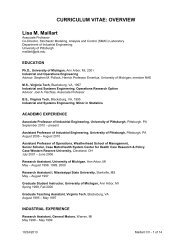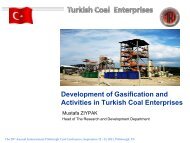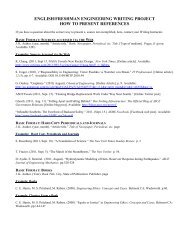Abstract Booklet 2006 - Swanson School of Engineering - University ...
Abstract Booklet 2006 - Swanson School of Engineering - University ...
Abstract Booklet 2006 - Swanson School of Engineering - University ...
You also want an ePaper? Increase the reach of your titles
YUMPU automatically turns print PDFs into web optimized ePapers that Google loves.
POSTER SESSION 1<br />
COMBUSTION TECHNOLOGIES<br />
P1-1<br />
Importance <strong>of</strong> the Lignite for Energy in Turkey<br />
Ilker Senguler, Mineral Research Institute (MTA), TURKEY<br />
Hayrullah Dagistan, General Directorate <strong>of</strong> Mineral Research and Exploration,<br />
TURKEY<br />
Energy is the main input for industrialization and development. In electrical power<br />
generation, the share <strong>of</strong> thermal plants is 64%. Because <strong>of</strong> their low capacity and high<br />
initial investment cost renewable energy sources are not preferred.<br />
Since the coal resources comprise 27% <strong>of</strong> all the energy sources, it will continue to<br />
take a role in the 21 st Century. 1.75% <strong>of</strong> these resources are located in Turkey and most<br />
<strong>of</strong> the electrical power generation is based on thermal power stations.<br />
Most <strong>of</strong> the known lignite deposits in Turkey are <strong>of</strong> low calorific value, high<br />
percentage <strong>of</strong> ash, volatile matter, moisture and sulphur. Almost 75% <strong>of</strong> the total<br />
reserves are with a calorific value <strong>of</strong> below 2500 kcal/kg. 17% are between 2500 and<br />
3000 kcal/kg. While only the 8% are over 3000 kcal/kg. Therefore, it is inevitable that<br />
the majority <strong>of</strong> such lignites which are feasible technically and economically for<br />
exploitation must be enriched by washing before marketing.<br />
Total installed capacity <strong>of</strong> based on lignite thermal power plants is 6390 MW in<br />
Turkey. In addition to 1760 MW (Can and Elbistan) is under testing. It is planned to<br />
have thermal power plants with capacities <strong>of</strong> power 13810 MW in 2010 and 16060 in<br />
2020.<br />
Coal exploration studies will be accelerated to correspond the energy deficiency <strong>of</strong><br />
Turkey. General Directorate <strong>of</strong> Mineral Research and Exploration <strong>of</strong> Turkey (MTA)<br />
will carry out a series <strong>of</strong> coal exploration projects in different regions <strong>of</strong> Turkey. As a<br />
result <strong>of</strong> these studies including drilling activities, the coal reserves will have been<br />
increased importantly.<br />
United Nations Framework Convention on Climate Change (UNFCCC) regulations<br />
stipulates that the green gas emissions should be dropped to 1990’s level. Therefore<br />
new combustion technologies are required for energy resources. The thermal power<br />
plant in Can, Canakkale, capacity <strong>of</strong> power 2x160 MW with fluidized bed combustion<br />
technology will be a good example for the future use <strong>of</strong> this application.<br />
Turkey possesses a large lignite potential with 8.3 billion tons. New combustion<br />
technologies and coal mining applications will make this potential more attractive in<br />
the near future. The sensibility to the environmental problems in Turkey can be taken<br />
as a guarantee that we will not face the environmental problems industrialized<br />
countries had faced before. We should not forget that “a living society is one that<br />
obtains its current needs without destroying the belongings <strong>of</strong> the next generations”.<br />
P1-2<br />
The Char-CO 2 Reaction at High Temperatures and Pressures<br />
Elizabeth Hodge, Daniel Roberts, David Harris, CSIRO Energy Technology – QCAT,<br />
AUSTRALIA<br />
John Stubington, UNSW, AUSTRALIA<br />
The rate <strong>of</strong> coal conversion in an entrained flow gasifier is limited by the rate <strong>of</strong><br />
reaction <strong>of</strong> char with steam and CO 2 . Under these conditions, rates <strong>of</strong> carbon<br />
conversion depend on the chemical reaction rate on the char surface and the rate <strong>of</strong> gas<br />
diffusion to the surface <strong>of</strong>, and within the pores <strong>of</strong>, the particle. For pulverised coal<br />
particles, at low temperatures (below about 900–1000°C) the conversion rate depends<br />
only on the chemical reaction rate. As temperatures increase, the influence <strong>of</strong> gas<br />
diffusion becomes significant and the conversion process becomes more complicated.<br />
Whilst the rate <strong>of</strong> the char–CO 2 reaction at high pressures has been investigated at low<br />
temperatures, few data exist that allow quantification <strong>of</strong> this reaction at high<br />
temperatures and pressures relevant to full-scale entrained flow gasifiers. This paper<br />
presents new data from measurements <strong>of</strong> the rate <strong>of</strong> the char–CO 2 reaction at<br />
temperatures up to 1400°C and pressures up to 20 bar in a pressurised entrained flow<br />
reactor. The data have been compared to reaction rates obtained at lower temperatures<br />
in order to begin to develop the link between low and high temperature reaction rates.<br />
P1-3<br />
Utilization <strong>of</strong> Energy Grasses for Combustion<br />
Dagmar Juchelkova, Helena Raclavska, Bohumir Cech, Jan Frydrych, David Andert,<br />
VSB-Technical <strong>University</strong> <strong>of</strong> Ostrava, CZECH REPUBLIC<br />
The highest degree utilization <strong>of</strong> domestic energetic sources and supply the<br />
information important for energetic conception <strong>of</strong> individual country and regions is the<br />
main request <strong>of</strong> EU government on research. Utilization <strong>of</strong> energy grasses is very<br />
important because <strong>of</strong> various reasons - social benefit, environmental benefit, country<br />
benefit, etc. The energy utilization <strong>of</strong> the energy grasses is one <strong>of</strong> the main topics for<br />
future developments <strong>of</strong> recoverable sources in the European Union and in the Czech<br />
Republic. The aim <strong>of</strong> research is combustion tests in the boilers <strong>of</strong> various producers<br />
located in the Czech Republic. The experiments are carried out for Czech grasses and<br />
wastes including analyses and recommendations for optimal thermal utilization and<br />
49<br />
minimizing harmful emissions. From the results <strong>of</strong> experiments and thermal modeling<br />
it is clear that near 38 % <strong>of</strong> energy grasses can be used in the large fluidized-bed<br />
boilers located in the Czech Republic. From energetic point <strong>of</strong> view has a growing<br />
importance the grass and permanent grass covers for biogas production. According to<br />
research projects the grass is the most suitable material for biogas generation because<br />
its high biological activity, high content <strong>of</strong> nutrients and easy cells degradability in all<br />
stages <strong>of</strong> moisture. The origin <strong>of</strong> solution is based on determination <strong>of</strong> grass mixtures<br />
suitable for combined combustion, determination <strong>of</strong> technological processes <strong>of</strong><br />
growing, harvest and fuel preparation and further determination <strong>of</strong> grass mixture<br />
suitable for biogas production. This paper presents only the results from the<br />
experiments <strong>of</strong> combustion <strong>of</strong> energy grasses.<br />
P1-4<br />
CO 2 Reduction Potential on the Czech Condition<br />
Dagmar Juchelkova, Helena Raclavska, Vaclav Roubicek, Pavel Kolat, Jiri Bilik,<br />
Darja Noskievicova, Pavlina Pustejovska, Jarmila DolezalovaVSB-Technical<br />
<strong>University</strong> <strong>of</strong> Ostrava, CZECH REPUBLIC<br />
At present the task <strong>of</strong> minimizing carbon dioxide emissions in relation to its influence<br />
on environment belongs to the priorities <strong>of</strong> EU research activities. For achieving the<br />
best possible results it is necessary to focus attention on information concerning input<br />
materials character study <strong>of</strong> production as well as manufacturing processes and<br />
subsequent returning the products back to environment (anthroposphere). The highest<br />
degree utilization <strong>of</strong> domestic energetic sources and supply the information important<br />
for energetic conception <strong>of</strong> individual country and regions is the main request <strong>of</strong> EU<br />
government on research. Reduction <strong>of</strong> CO 2 production can begin if following<br />
information will be known:<br />
- Character <strong>of</strong> input materials (content <strong>of</strong> C, H, N, S and TOC - total organic carbon),<br />
pollutants, physical-chemical properties, determination <strong>of</strong> phase occurrence, amount <strong>of</strong><br />
input materials etc.).<br />
- Production and technological processes (energy demand technological limits for<br />
realization <strong>of</strong> IPPC and LAC etc.).<br />
- The utilization and character <strong>of</strong> by-products (evaluation <strong>of</strong> properties → processing<br />
for other kind <strong>of</strong> utilization or alternative technology for disposal).<br />
P1-5<br />
The Rheology <strong>of</strong> Coal-Oil Mixtures (COM)<br />
Gunduz Atesok, Mustafa Ozer, Feridun Boylu, Istanbul Technical <strong>University</strong>,<br />
TURKEY<br />
Today 90% <strong>of</strong> electricity in the world is produced from fossil fuels such as coal, oil<br />
and natural gas. Oil equivalent <strong>of</strong> fossil in the world is calculated to be 68% coal, 18%<br />
oil and 14% natural gas. According to these figures the lifetime <strong>of</strong> oil, natural gas and<br />
coal is 40, 60 and 220 years respectively. Coal water slurries (CWS) and coal oil<br />
mixtures (COM) may be an alternative energy source to fuel-oil. In COM or CWS<br />
technology, the coal loading rate is an important factor and it depends on the rheology<br />
<strong>of</strong> mixtures.<br />
In this study, the COM was prepared using fuel-oil(#6) and high rank bituminous coal<br />
at a temperature range 20 to 90°C and coal loading rate were examined. The results <strong>of</strong><br />
the study showed that the rheology <strong>of</strong> COMs loaded with high amount <strong>of</strong> coal as much<br />
as 60% could be advanced by increasing the mixture temperature to 90°C. However,<br />
for slurries with suitable viscosity, the mixture temperature at 60°C is found to be<br />
enough with lower coal loading rates such as 50%.<br />
In conclusion, it was found that fuel-oil can be loaded with high amount <strong>of</strong> solids using<br />
high rank coals. Thus, the consumption rate <strong>of</strong> fuel-oil could be decreased without<br />
sacrificing on the heating value <strong>of</strong> the new fuel, COM.<br />
POSTER SESSION 2<br />
GASIFICATION TECHNOLOGIES / HYDROGEN FROM COAL<br />
P2-1<br />
Carbon Dioxide Capture and Separation Techniques for Advanced Power<br />
Generation Point Sources<br />
Henry Pennline, David Luebke, Badie Morsi, Yannick J. Heintz, Kenneth L. Jones,<br />
Jeffery B. Ilconich, DOE/NETL, USA<br />
The capture/separation step for carbon dioxide (CO 2 ) from large-point sources is a<br />
critical one with respect to the technical feasibility and cost <strong>of</strong> the overall carbon<br />
sequestration scenario. For large-point sources, such as those found in power<br />
generation, the carbon dioxide capture techniques being investigated by the in-house<br />
research area <strong>of</strong> the National Energy Technology Laboratory possess the potential for<br />
improved efficiency and costs as compared to more conventional technologies. The<br />
investigated techniques can have wide applications, but the research has focused on<br />
capture/separation <strong>of</strong> carbon dioxide from flue gas (postcombustion from fossil fuelfired<br />
combustors) and from fuel gas (precombustion, such as integrated gasification<br />
combined cycle – IGCC). With respect to fuel gas applications, novel concepts are<br />
being developed in wet scrubbing with physical absorption; chemical absorption with














